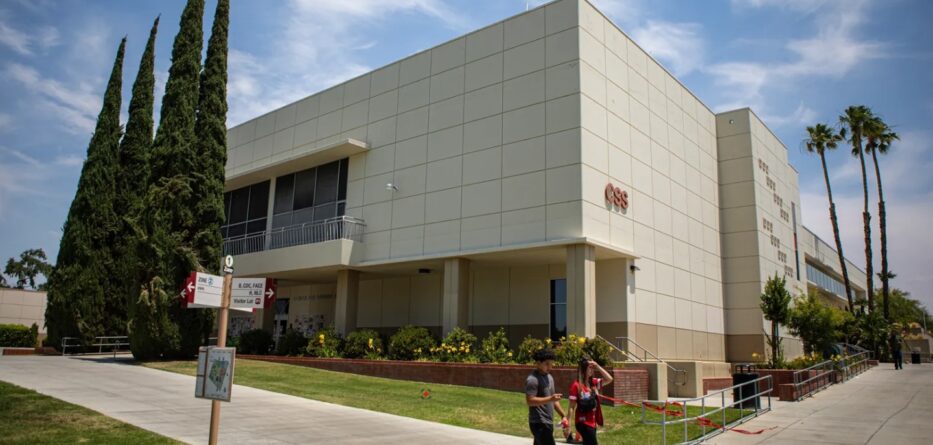Adam Echelman
CalMatters
Grizzled farmworkers are the hot new commodity as community colleges try to reverse a years-long enrollment decline.
When the COVID-19 pandemic hit, the “golden age” of higher education — where more and more adults were attending college every year — came to a halt, and California’s community college enrollment plummeted to a 30-year low.
The state community college system lost hundreds of thousands of students, but it was those 50 years and older who left at the highest rates compared to other age groups.
From Siskiyou County, on the border with Oregon, to the Inland Empire, college leaders told CalMatters how older, low-income adults often had to work “essential” jobs or to step back into the workforce to support their families. Because of their age, they faced an increased risk of COVID-19. Many were less comfortable using Zoom or they lacked an adequate internet connection for online classes. As a result, these older students left their college ambitions to the wayside during the pandemic.
Now they are also trying to reel older students back in with new programs and concerted outreach efforts. While some colleges have managed to buck the downward trends, others have found themselves competing for the same students.
Enrolling farmworkers
During the pandemic, the College of the Sisikyous saw one of the biggest enrollment declines across all age groups.
With roughly 2,500 fewer students total in 2021-22 compared to the 2018-19 academic year, the College of the Siskiyous could lose about $2.3 million dollars — just over 10% of its total funding.
Compared to other age groups, students over 50 years old left at the highest rates. And it’s a problem that’s been happening for years, even before the pandemic: COVID-19 was just “the straw that broke the camel’s back,” said Samantha Worthington, who oversees adult education at the college.
Instead, the college’s enrollment issues began as a result of competition from other schools.
Similar to many California community colleges, which have looked to out-of-state residents and even international students, administrators at the College of the Siskiyous started to look beyond the county line about seven years ago, especially for older students.
The college partnered with an organization called the Farmworker Institute on Education and Leadership Development to offer classes to farmworkers who live hundreds of miles south in places such as Monterey and Kern counties. Often, these students study to improve their English, to learn new career skills, or work towards a degree.
In the 2017-18 academic year, the College of the Siskiyous enrolled 827 farmworkers over the age of 50 in the program.
This year, the College of the Siskiyous has 11 such students over 50 years old.
Along with consistently low wages, these farmworkers had high rates of COVID-19 infection and few worker protections that ultimately pushed them away from classes, Worthington said.
Community college enrollment decline and competition
The decline in students is also because other colleges — faced with their own declining enrollment numbers — saw an opportunity to target the same students.
In 2021, Bakersfield College launched a partnership with the same nonprofit organization to target local farmworkers and declined to sign the collaborative contract it had previously made with the College of the Siskiyous.
Bottom of Form
In the course of a few years, Bakersfield College launched a flurry of new initiatives, all aimed at boosting enrollment for older students. Administrators opened new teaching centers in South Bakersfield and in the rural town of Wasco. They created a new program to educate people experiencing homelessness and another one, in partnership with the local school district, to teach parents about child development.
From the 2018-19 academic year to 2021-22, the most recent year with verified enrollment data, Bakersfield saw an increase of more than 41% in students over the age of 50, the largest increase of all the state’s 116 community colleges.
Bakersfield College is also a leader in enrolling high school students. In fact, the new California Community College Chancellor Dr. Sonya Christian — a former Bakersfield College president — has said she wants to enroll every 9th grader in a college course, something she first piloted in Kern County.
Now, College of the Siskiyous has turned its attention from farmworkers to prisoners, joining the many colleges who seek to enroll more incarcerated students. The college is also preparing for budget cuts. For example, Fields said the college is canceling classes with only five or six students.
Popularity of noncredit courses
The key to recruiting and retaining older students lies in the way which classes are taught, but most colleges aren’t making the necessary changes, said Kathy Booth, a project director at the education research group WestEd.
To lure older students to school, community colleges need to offer flexible and engaging courses that have clear and specific career outcomes. “The most frequent award that’s given out is a general studies associate’s degree,” she said. “There are very few employers that are asking for associate’s degrees outside of a few technical fields, so that sort of general education is less valuable to a working adult.”
Instead, adults over the age of 50 often want to take noncredit courses, which do not count toward degrees. Noncredit courses are short, free and typically vocational, covering topics such as HVAC repair.
But across the state, colleges struggled to move many of the most popular noncredit courses, such as those in automotive repair, healthcare, and early childhood development, to an online format.
In the 2021-22 academic year, Mt. San Antonio College had about 34,000 students taking noncredit classes, the largest volume of students in the state. Like most colleges, Mt. San Antonio saw a drop in the number of students over 50 who enrolled since the start of the pandemic.
Madelyn Arballo, the vice president of continuing education, is not worried, though. “The first year of the pandemic was really bad, but the second year, we rebounded,” she said. Arballo expects that the college has already reached pre-pandemic levels once the final numbers are tallied for the recent spring semester.
Moving quickly
Arballo attributed some of Mt. San Antonio’s success to her department putting together new classes and certificates quickly, such as a course on COVID-19 contact tracing that it offered for just a few months. Of the 103 students who enrolled in contact tracing courses in the 2021-22 academic year, 41% were over the age of 46, she wrote to CalMatters.
Instead of telling prospective students why they should go to college, she tries to tell students what they could earn or do after college: Contact tracers, for instance, were making $25 an hour at the time the class was running.
Even though these adult students often start out taking one or two quick, noncredit classes, they may end up working towards an associate’s degree, or even transferring to a four-year university, once they realize the earning potential of a bachelor’s degree, said Arballo.
Marcelo Baca, 62, started taking noncredit courses last year in an effort to get his GED, but he isn’t stopping there. He plans to graduate with an associate’s degree in business and then transfer to California State University Fullerton to ultimately become a financial advisor.
It’s not his first attempt at a degree. He immigrated from Argentina in 1989 to attend community college in Orange County, but he couldn’t afford it and dropped out. He became undocumented and despite living in the state for decades, he was ineligible for financial aid. When he was finally in a position to restart school, he said he was diagnosed with colon cancer, and later, sent to the ICU for complications due to COVID-19.
Now he’s finally pursuing his dream, even if his children beat him to it.
“I may be super old, but I don’t care.”
Adam Echelman covers California’s community colleges in partnership with Open Campus, a nonprofit newsroom focused on higher education.






